<< Previous | Displaying results 4776-4800 of 6769 for "" | Next >>
A Polish former inmate of Auschwitz identifies Oswald Pohl while on the stand for the prosecution during the Pohl/WVHA trial. This trial, case #4 of the Subsequent Nuremberg Proceedings, took place in a room in the Palace of Justice which was not the main courtroom. Nuremberg, Germany, April 18, 1947.
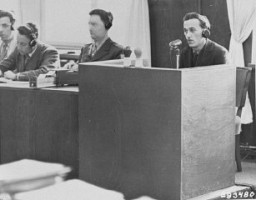
View of the courtroom as seen from the interpreters' section during the IG Farben Trial. The defense lawyers are in the foreground, the defendants are in the dock to the right, and the spectators' gallery is on the far side of the courtroom.
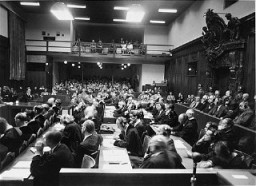
US Chief of Counsel Brigadier General Telford Taylor (standing at center podium) opens the prosecution's case at the IG Farben Trial. Note the camera in the corner of the room. August 27, 1947.

The IG Farben defendants hear the indictments against them before the start of the trial, case #6 of the Subsequent Nuremberg Proceedings. May 5, 1947.
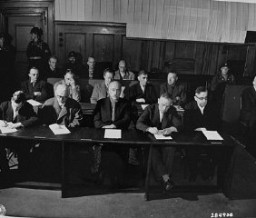
The defendants in the dock (at rear, with headphones) and their lawyers (front) follow the proceedings of the Hostage Case, case #7 of the Subsequent Nuremberg Proceedings. Nuremberg, Germany, 1947-48.

US Brigadier General Telford Taylor (front right), chief of counsel, sits at the prosecution table with his staff during the reading of charges against the defendants in the RuSHA Trial. October 10, 1947.
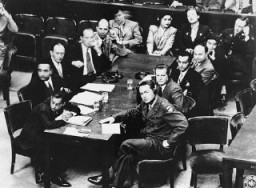
Defendant Inge Viermetz pleads not guilty at her arraignment during the RuSHA Trial, case #8 of the Subsequent Nuremberg Proceedings. October 10, 1947.
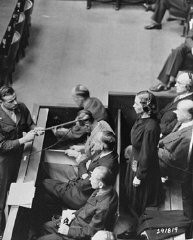
The courtroom during the Einsatzgruppen Trial of the Subsequent Nuremberg Proceedings. Chief Prosecutor Benjamin Ferencz stands in the center of the room. He is presenting evidence. Nuremberg, Germany, between September 29, 1947, and April 10, 1948.
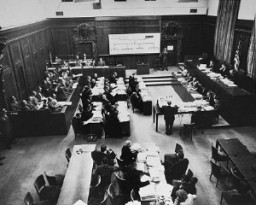
Chief Prosecutor Benjamin Ferencz presents evidence during the Einsatzgruppen Trial, Case #9 of the Subsequent Nuremberg Proceedings. Ferencz is flanked by German defense lawyers Dr. Friedrich Bergold (right, counsel for Ernst Biberstein) and Dr. Rudolf Aschenauer (left, counsel for Otto Ohlendorf), who are protesting the introduction of certain documents as evidence.
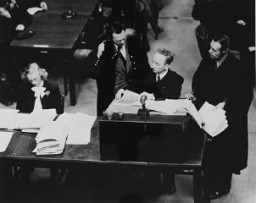
US prosecutor Robert Kempner during the Ministries Trial, case #11 of the Subsequent Nuremberg Proceedings.

The defendants in the dock (right) and their lawyers (center) listen to trial proceedings during the High Command Case.
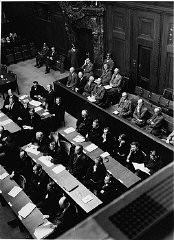
View of the main entrance to the Auschwitz camp. The sign above the gate says "Arbeit Macht Frei" (Work makes one free). Auschwitz, Poland, date uncertain.
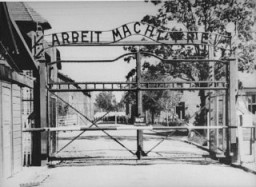
View of the kitchen barracks, the electrified fence, and the gate at the main camp of Auschwitz (Auschwitz I). In the foreground is the sign "Arbeit Macht Frei." This photograph was taken after the liberation of the camp by Soviet forces. Auschwitz, Poland, 1945.
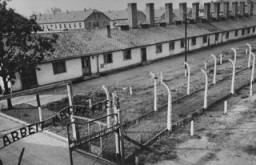
A member of the German SS supervises the boarding of Jews onto trains during a deportation action in the Krakow ghetto. Krakow, Poland, 1941–1942.
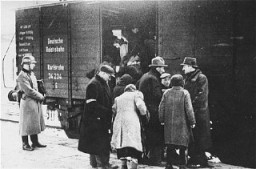
Installation of the railcar at the construction site of the United States Holocaust Memorial Museum. Washington, DC, February 9, 1991.
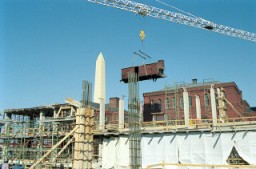
View of the railcar on display in the Permanent Exhibition of the United States Holocaust Memorial Museum. Washington DC, June 19, 1991. Courtesy of Polskie Koleje Panstwow S.A.
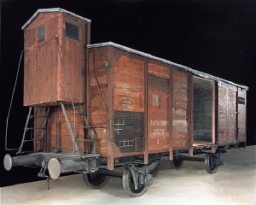
Heinrich Himmler (seated, center), chief of the SS, with Reinhard Heydrich (standing, left), chief of the Security Police and SD. Berlin, Germany, 1938.

Third meeting of the board of directors of the War Refugee Board. From the left are Secretary of State Cordell Hull, Treasury Secretary Henry Morgenthau, Secretary of War Henry Stimson, and Executive Director John Pehle. Washington, DC, United States, March 21, 1944.
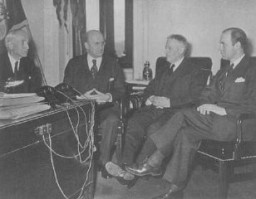
Henry Morgenthau, Jr., treasury secretary in the Roosevelt administration and later chairman of the United Jewish Appeal, greets Jewish refugees en route from Shanghai to Israel. New York, United States, March 2, 1949.

Adolf Hitler (center) with (from left to right): Heinz Riefenstahl, Frau Dr. Ebersberg, Leni Riefenstahl, Joseph Goebbels, and Ilse Riefenstahl. Germany, date uncertain.
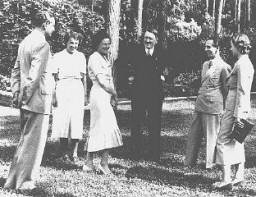
Leni Riefenstahl, with Adolf Hitler in the background, directs the shooting of a film about the Reich Party Day. Here she is shooting a segment called "Day of the Reich Work Service." Nuremberg, Germany, 1936.
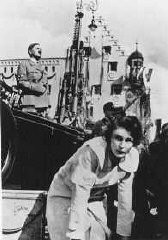
President Franklin D. Roosevelt in the Oval office at the White House, shortly before delivering a speech accepting the Democratic Party's presidential nomination. Washington, DC, United States, July 24, 1940.
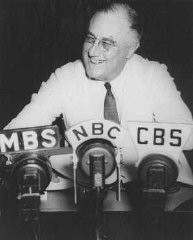
A crowd in front of the Berlin Cathedral (Berliner Dom) cheers the declaration of World War I. Berlin, Germany, August 1914. Many enthusiastically believed that World War I would be over quickly. Instead, the war became a stalemate of costly battles and trench warfare. It lasted for years and was the first great international conflict of the twentieth century. The impact of the conflict and its divisive peace would reverberate in the decades following.
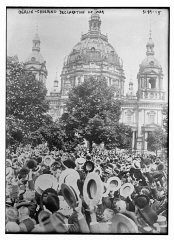
Refugees in the Gare de Lyon in Paris during World War I. Paris, France, photograph taken ca. 1914–15.
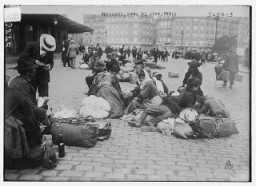
Belgian refugees in Paris during World War I, the first great international conflict of the twentieth century. Paris, France, 1914.
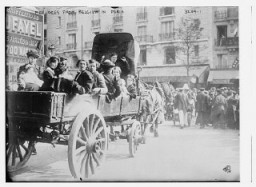
We would like to thank Crown Family Philanthropies, Abe and Ida Cooper Foundation, the Claims Conference, EVZ, and BMF for supporting the ongoing work to create content and resources for the Holocaust Encyclopedia. View the list of donor acknowledgement.